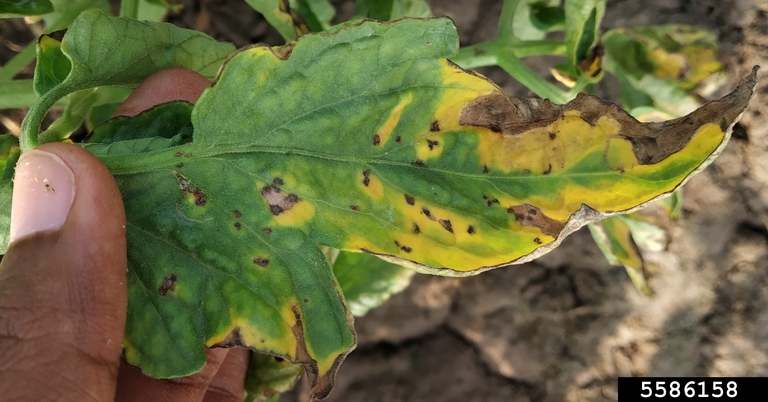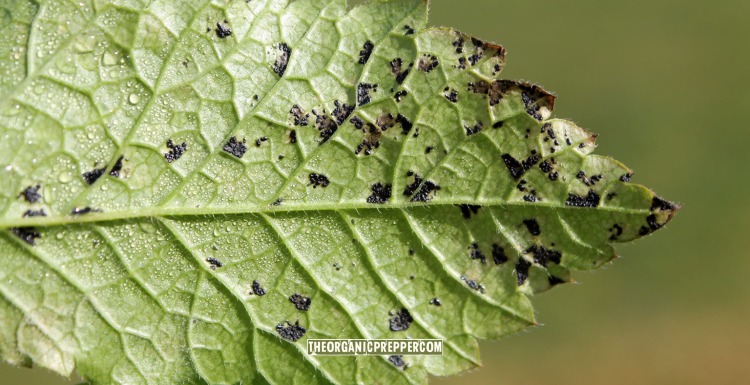If you're new here, you may want to subscribe to my RSS feed. Thanks for visiting!
So you’re checking out your tomatoes one day and see these funky splotches on the leaves. They’re black or brown, maybe whitish in the center with a dark brown margin and yellow ring, and some look like they’ve merged into one big splotch. Being a curious soul, you take a peek through a magnifying glass and see structures that look like dark brown pimples. You make a note of this, as it might be important for the differential diagnosis. Your gardener’s gut tells you that this requires further investigation, and to work, you go!
You’ve already noted the specific plant and the signs in the leaves. You remember that the weather has been rainy and humid for the past few weeks, perfect for both bacteria and fungi. Depending upon when you noticed, there may be either a few plants involved or several. You make a note of the fact that it’s the lower, older leaves primarily, but not exclusively. You might even see spots on the stems, blossoms, or calyxes! Isn’t detective work fun?
A bit of research later, you see pictures that look quite a lot like your plant.
The article informs you that you’ve got Septoria leaf spot, a fungal disease that commonly hits tomatoes and a few other members of the Solanaceae family, such as eggplant and potatoes.

The causal organism on tomatoes is Septoria lycopersici. The genus Septoria contains over 1000 species affecting many, many plants, including pistachios and even cannabis! Once symptoms appear, it’s difficult to control and will defoliate your plants, rendering them unable to produce. Those pimples you saw under magnification are the fruiting bodies, called pycnidia, an important point that differentiates Septoria from other leaf spots. This must be dealt with. There’s no letting the disease runs its course, not if you want tomatoes.
How do you control Septoria?
If you’ve caught this early enough, you may be able to control it with neem oil and trimming the affected leaves. Those are the most organic methods, and if they work, that’s a good thing. I tried those to no avail. My plants were totally defoliated, along with a 90% crop loss. The method that worked for me was copper fungicide, organic as pesticides go.
Potassium bicarbonate might also work. Be sure to follow label directions, like any other medication. The usual caveat about pesticide overuse definitely applies; use only as much as required to control the disease and no more!
Once the disease is controlled, then stop using it, but keep a sharp eye. Sometimes these things come back. A biological fungicide containing Bacillus subtilis might be worth a try. If you’re really in a bind, consider chemical fungicides. Chlorothalonil (sold as Fungonil and Daconil) is considered the most effective and least toxic. Remember, these pesticides are definitely a last resort!
So, what else can be done?
Septoria is a spore-forming fungus. Spores are the fungal version of seed, for those who don’t know. Spores lie in the soil & infected plant waste, and they overwinter, meaning you’ll have this problem again next year if you don’t take some action. During the season, mulch can help keep spores from splashing up onto the plants.
Watering from above can also spread disease, so it’s best to use soaker hoses or drip systems if available and feasible. But tell that to a good rainstorm, right? That may be how it came to the garden in the first place. Make sure you have good air circulation and remove all diseased plants from the garden.
Don’t put these in your compost pile! Spores, like any other seed, can withstand quite a lot. It would be best to burn them, but that’s not always an option, especially in the city. I send mine to the city compost pile. This is the biggest reason I’d never use compost from there! I’m sure other gardeners send their less desirable waste there as well. Oh well. Life isn’t a perfect process.
Crop rotation can help you to keep diseases in check.
Crop rotation has many benefits, including the removal of plants from the diseases that love them. Plant something in that area that Septoria won’t infect, if possible. Granted, small space gardeners will have problems with this one; just do the best you can. Disease-resistant varieties are another possibility, although that too comes with a caveat: resistance is far from a guarantee and can diminish over time. But it’s worth a try.
Good garden hygiene is a must! Always clean your hands and your tools with mild bleach, such as a Clorox wipe or similar. This helps keep many ills to a minimum or even nonexistent state. Good luck!
(Just in case you lose more plants than you bargained for, it’s probably a good idea to read our free QUICKSTART Guide to building a 3-layer food storage plan.)
Lessons in gardening: recent notes on Septoria
While dealing with Septoria on my tomatoes, I noticed similar spots on my strawberries in the next bed, about two feet over. This is very unhappy news! Now I’ve got TWO beds full of it, with another strawberry bed close by?? Bummer!
Just to be thorough, I researched Septoria on strawberries and made the coolest discovery: Septoria does not attack strawberries. It does, however, attack Potentilla, the mock strawberry.
Potentilla has a very similar growth habit, differing only in the flower, which is solid yellow rather than with a yellow center with white petals. It does produce a fruit, but I’ve yet to read an article that calls the fruit tasty, so I usually pull them as soon as I discover them. Septoria made plant differentiation easy, and I pulled the Pretender mercilessly! Even a difficult situation can be useful.
Septoria doesn’t have to be the end of your garden.
Plant diseases are a natural part of gardening. Should Septoria decide to visit your tomato crop, don’t lose heart. There are actionable steps that you can take to minimize the damage and prevent its happening again in the future. What are your thoughts on the situation? Are there other means by which you have successfully battled Septoria? Let us know in the comments below.
About Amy Allen
Amy Allen is a professional bookworm and student of Life, the Universe, and Everything. She’s also a Master Gardener with a BS in biology, and has been growing food on her small urban lot since 2010.

















Thanks for sharing this Amy. I haven’t had to deal with this so far but am glad to know about. I appreciate knowing the remedies to resolve this if it becomes an issue.
You’re welcome! Good luck.
I’ve had to deal with this that past 2 seasons and found the Daconil worked, however, I didn’t catch it early enough, but will this year. I’ll do more mulch this year too. I use an drip irrigation system that works well, but I’ll need to position the little sprinkler head with more mulch around it. Good article, thanks.
I feel ya! Once this showed up in my garden, I’ve had it every year since. I use copper fungicide and early detection definitely helps. The other thing I’m going to try is spacing-lots of room between plants. This was recommended in one of the Extension classes I took this winter. We’ll see, right?
1. If it is not good enuf for your own garden, then it is immoral to pollute the city compost with it. Send it to trash.
2. You need to read some books by Eliot Cole. He treats plant pests as diseases, discovering and repairing the cause–and he wins.
Here in NE Florida, fungi and bacteria are rampant. I lost all of my strawberries and about half my tomatoes to one or the other. I started with neem oil, then daconil on spots then finally copper. None of it has really worked. Maybe it’s my timing and application but in about a week I’m going to uproot everything left and heat sterilize the soil by covering with clear plastic and allow the Florida sun to irradiate it. We’ll see how the winter garden does.